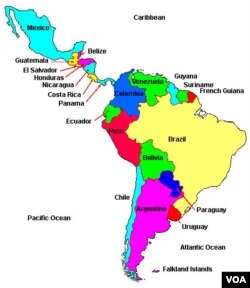Student Union
The US in Words #6: Pinned Down (How I Discovered my Own Identity)
To pin (something/someone) down = to get exact or specific information on/from
There were a few things I was sure I was before coming to the United States: blond, big, and Uruguayan. However, all of these things, which were part of my identity, seemed to blur and fade upon my arrival here.
The first time I ever stopped to think consciously about fitting my ethnicity and skin color into a category was on the plane from Uruguay to Miami, when I was asked to fill out a customs form (if you ever travel to the U.S., you will have to fill in one of those). It gave me options for Latina, Hispanic or White. I didn't know which to pick and eventually made a random decision to placate a less-than-patient agent at the airport.
After having been in this country for about five months, I have since given the question a lot more thought than I ever thought I would.
In my first semester here, I took a class called Race and Ethnicity in U.S. Literature. The class helped me understand the dynamics of a country as diverse as the United Sates, and it made me see that simply because it is diverse does not mean that everybody embraces diversity and accepts it as a good thing. I learned about how different ethnic groups have suffered and what their communities did to own their heritage and overcome any difficulties they faced. But most importantly, I reflected a great deal on who I am in relation to race and ethnicity.
I come from a country where ethnic diversity is scarce. Our native populations were largely killed off when the Spanish set foot on what today is Uruguay, so most of the population has European origins, primarily Spanish, Portuguese and Italian. My very own roots are Spanish for the most part, but I also have some Portuguese and German heritage.
Some people in the U.S. seem to have difficulties in “categorizing” me, and that makes them uneasy. I have realized that some people find it surprising, or even disturbing, that I look White but that I am Latina. Once, for instance, my friends were talking to a guy from Puerto Rico in Spanish. When I approached to join the conversation and spoke Spanish with my clearly rioplatense accent (an accent unique to Uruguay and some parts of Argentina), the guy looked at me and said, “But … you’re white!”
This wasn’t the only time when people pointed out the difference between my looks and origin. Many Americans would typically expect someone who claims to be Latino to have tanned skin and certain facial features common to only certain regions of Latin America, such as Mexico or Cuba, which have some of the largest numbers of immigrants from Latin America in the U.S. But this is a rather narrow-minded, if not ignorant, view of the concept of Latinism, which embraces a whole continent of multiple and very diverse origins, cultures and traditions.
So what is it that makes me who I am? Is geography the decisive factor in determining my ethnic origin? In that case I am Latina, for I come from a country located in Latin America.
Are my language and my culture what define who I am? Then I am Hispanic, for I speak Spanish, drink mate, dance tango and sing folklore songs.
Do my looks (or the blood that runs through my veins) speak about my identity? Then I am White, for I have fair skin, light-colored hair and light-blue eyes, and my kindred are entirely European.
I have never liked to label people and to put them into categories; I have always felt that reduces them to something much smaller than the whole being they truly are. That is why I have decided, thanks to the insight I have gained in taking my class and pretty much just by living here, that I am happy to be all of them. Yes, I am a Hispanic White Latina, as crazy as that may sound.
I am especially proud of having started thinking of myself as Hispanic and Latina, because I never gave this any importance when I lived in Uruguay. It was only when I came to the United States and became an outsider that I had to think which groups I identified with and why. To be able to embrace the three identities makes me more of who I am, so it makes me stronger.
I have come to the conclusion that being more aware of my ethnic roots has made me more confident and that I like having added more “names” to my identity checklist. I don’t think we are just our labels and categories - we are a lot more, and we shouldn’t try to pin people down with one label - but we can add those characteristics to the whole package of traits and communities and practices and traditions that make us who we are.
Editor's Note: In the past week we've been talking a lot about race in America, and the benefits and challenges of living in a diverse country. Read some additional perspectives on race:
- When Your Race is Not the Only Race: An Education in Diversity, by Zita
- Silence is Stronger Than Hate Speech, by Phillip
- Are Foreign Students Stereotyped by American Classmates?
See all News Updates of the Day
With federal student aid delays, students aren’t sure what college will cost

The U.S. Department of Education’s federal student aid form (FAFSA) experienced serious glitches and delays this year.
Now, many students have been admitted to college, but don’t know how much money they’ll need to attend.
Read the story from Susan Svrluga and Danielle Douglas-Gabriel for The Washington Post. (March 2024)
Senator draws attention to universities that haven’t returned remains

More than 70 U.S. universities continue to hold human remains taken from Native American burial sites, although those remains were supposed to be returned 30 years ago.
Jennifer Bendery writes in Huffington Post that one senator has been using his position in an attempt to shame universities into returning remains and artifacts. (April 2024)
COVID forced one international student to go hungry

When Samantha (not her real name) enrolled in community college in the U.S., her family at home in South Africa scrimped and saved to support her.
But the COVID-19 pandemic hurt the family’s finances, and at one point Samantha had four on-campus jobs just to make ends meet. Many in the U.S. believe international students are wealthy sources of funding for universities, but stories like Samantha’s suggest otherwise.
Andrea Gutierrez reports for The World. (March 2024)
Tips for paying for a STEM degree as an international student

For US News & World Report, Melanie Lockert describes how to calculate the cost of a STEM degree, and where to find funding. (March 2024)
NAIA all but bans its transgender college athletes from women's sports

The National Association of Intercollegiate Athletics, the governing body for mostly small colleges, announced a policy Monday that all but bans transgender athletes from competing in women's sports.
The NAIA's Council of Presidents approved the policy in a 20-0 vote. The NAIA, which oversees some 83,000 athletes at schools across the country, is believed to be the first college sports organization to take such a step.
According to the transgender participation policy, all athletes may participate in NAIA-sponsored male sports but only athletes whose biological sex assigned at birth is female and have not begun hormone therapy will be allowed to participate in women's sports.
A student who has begun hormone therapy may participate in activities such as workouts, practices and team activities, but not in interscholastic competition.
"With the exception of competitive cheer and competitive dance, the NAIA created separate categories for male and female participants," the NAIA said. "Each NAIA sport includes some combination of strength, speed and stamina, providing competitive advantages for male student-athletes. As a result, the NAIA policy for transgender student-athletes applies to all sports except for competitive cheer and competitive dance, which are open to all students."
There is no known number of transgender athletes at the high school and college levels, though it is believed to be small. The topic has become a hot-button issue for those for and against transgender athletes competing on girls' and women's sports teams.
At least 24 states have laws barring transgender women and girls from competing in certain women's or girls sports competitions. Last month, more than a dozen current and former college athletes filed a federal lawsuit against the NCAA, accusing the sports governing body for more than 500,000 athletes of violating their rights by allowing transgender women to compete in women's sports.
The Biden administration originally planned to release a new federal Title IX rule — the law forbids discrimination based on sex in education — addressing both campus sexual assault and transgender athletes. But earlier this year, the department decided to split them into separate rules, and the athletics rule now remains in limbo even as the sexual assault policy moves forward.
Hours after the NAIA announcement, the NCAA released a statement: "College sports are the premier stage for women's sports in America and the NCAA will continue to promote Title IX, make unprecedented investments in women's sports and ensure fair competition for all student-athletes in all NCAA championships."
The NCAA has had a policy for transgender athlete participation in place since 2010, which called for one year of testosterone suppression treatment and documented testosterone levels submitted before championship competitions. In 2022, the NCAA revised its policies on transgender athlete participation in an attempt to align with national sport governing bodies, following the lead of the U.S. Olympic and Paralympic Committee.
The three-phase implementation of the policy included a continuation of the 2010 policy, requiring transgender women to be on hormone replacement therapy for at least one year, plus the submission of a hormone-level test before the start of both the regular season and championship events.
The third phase adds national and international sport governing body standards to the NCAA's policy and is scheduled to be implemented for the 2024-25 school year on August 1.
There are some 15.3 million public high school students in the United States and a 2019 study by the CDC estimated 1.8% of them — about 275,000 — are transgender. The number of athletes within that group is much smaller; a 2017 survey by Human Rights Campaign suggested fewer than 15% of all transgender boys and transgender girls play sports.
The number of NAIA transgender athletes would be far smaller.








